NURS1102 - Nurses' Role in Seclusion Reduction in Mental Health
VerifiedAdded on 2023/06/07
|11
|2573
|100
Report
AI Summary
This report explores the role of nurses in reducing the practice of seclusion in mental health settings, a practice often viewed as a violation of human rights. Through a review of twelve relevant research articles, the study identifies key factors influencing the use of seclusion, including the quality of interpersonal relationships between nurses and patients, cultural differences leading to misinterpretations of patient behavior, and a perceived lack of alternative approaches. The report highlights that nurses who support seclusion often prioritize a safe working environment, while opponents emphasize the potential for physical and psychological harm. Recommendations for reducing seclusion include fostering strong nursing leadership, promoting engagement and empathy with patients, providing comprehensive education and training, and creating a supportive environment that prioritizes alternative therapeutic options. The report concludes that a multifaceted approach involving organizational support, well-educated staff, and a commitment to ethical considerations is essential for minimizing the use of seclusion in mental health care.
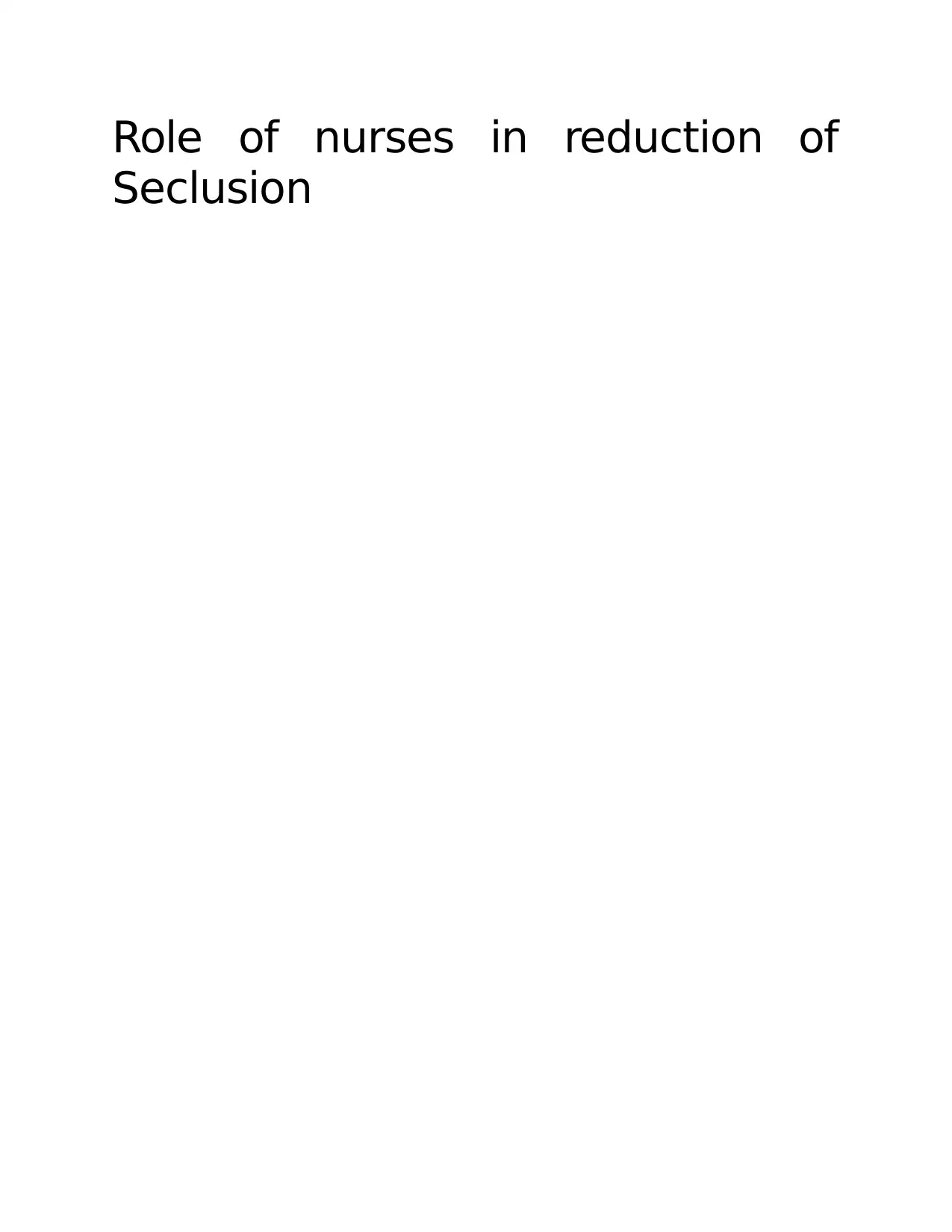
Role of nurses in reduction of
Seclusion
Seclusion
Paraphrase This Document
Need a fresh take? Get an instant paraphrase of this document with our AI Paraphraser

Abstract
Incidence of seclusion is often considered to be a violation of the basic human rights of an
individual and as a result seclusion as a treatment approach is often looked down upon by the
medical community. Nurses in medical establishments who are responsible for directly caring for
the patients are mainly involved in the initiation or management of seclusion that the mental
patients are subjected to in mental health settings. For evaluating the aspect of seclusion in a
mental health setting, the researcher has examined the available literature on the same topic from
diverse sources. The researcher had eventually selected 12 research journals and articles which
they considered to be relevant to their chosen research topic in order to gather an in-depth
knowledge about the role of nurses in contributing towards the aspect of seclusion in a mental
health setting. After reviewing the available literature, it has been found that there are various
reasons responsible for aggressive and violent behavior among the mental patients and the most
important among them is the interpersonal relationship and environments that the mental patients
are subjected to on a daily basis which eventually evokes a response from the patients in the
form of violent behaviour. Moreover, cultural difference between the nurses and the patients was
another vital factor that eventually created a misinterpretation of patients’ behavior as
aggressive. Nurses on their part, were asserting that the lack of alternative approaches to
seclusion towards dealing with the mental health disorders was one of the most crucial reasons
which forced them to implement seclusion in a mental care setting.
Incidence of seclusion is often considered to be a violation of the basic human rights of an
individual and as a result seclusion as a treatment approach is often looked down upon by the
medical community. Nurses in medical establishments who are responsible for directly caring for
the patients are mainly involved in the initiation or management of seclusion that the mental
patients are subjected to in mental health settings. For evaluating the aspect of seclusion in a
mental health setting, the researcher has examined the available literature on the same topic from
diverse sources. The researcher had eventually selected 12 research journals and articles which
they considered to be relevant to their chosen research topic in order to gather an in-depth
knowledge about the role of nurses in contributing towards the aspect of seclusion in a mental
health setting. After reviewing the available literature, it has been found that there are various
reasons responsible for aggressive and violent behavior among the mental patients and the most
important among them is the interpersonal relationship and environments that the mental patients
are subjected to on a daily basis which eventually evokes a response from the patients in the
form of violent behaviour. Moreover, cultural difference between the nurses and the patients was
another vital factor that eventually created a misinterpretation of patients’ behavior as
aggressive. Nurses on their part, were asserting that the lack of alternative approaches to
seclusion towards dealing with the mental health disorders was one of the most crucial reasons
which forced them to implement seclusion in a mental care setting.
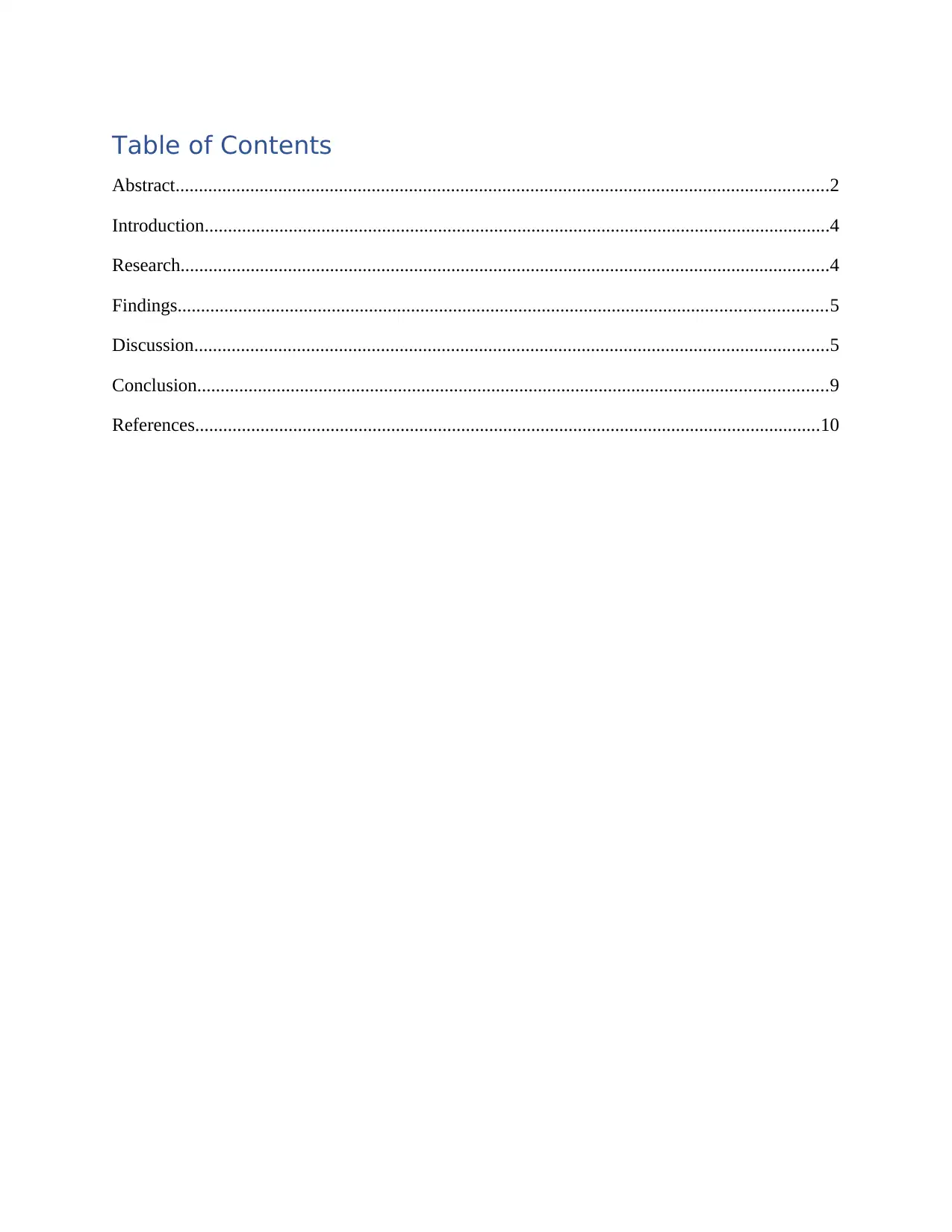
Table of Contents
Abstract............................................................................................................................................2
Introduction......................................................................................................................................4
Research...........................................................................................................................................4
Findings...........................................................................................................................................5
Discussion........................................................................................................................................5
Conclusion.......................................................................................................................................9
References......................................................................................................................................10
Abstract............................................................................................................................................2
Introduction......................................................................................................................................4
Research...........................................................................................................................................4
Findings...........................................................................................................................................5
Discussion........................................................................................................................................5
Conclusion.......................................................................................................................................9
References......................................................................................................................................10
⊘ This is a preview!⊘
Do you want full access?
Subscribe today to unlock all pages.

Trusted by 1+ million students worldwide

Introduction
Seclusion is defined as the forced confinement of an individual alone in a locked room or in an area
where the individual is physically stopped from leaving (APNA, 2014). Seclusion is used as an
intervention in mental health settings to manage violent and self-destructive behavior. However,
its implementation is controversial. Its implementation is conflicting with the international
guidelines and recommendations, government reports, mental health service policies, and a
literature support that seclusion as a policy to handle with disturbed behavior must be used in the
least to absolutely no amount. It is seen as a human rights issue and believed that it has no
therapeutic value and has only caused emotional and physical harm. This research is conducted
to evaluate the role of nurses in reduction of the practice of seclusion.
Research
The usage of seclusion is controversial as it is also regraded as a forced activity with negative outcomes
for the clients as well as the staff. Yet this strategy is used regularly as an intervention in mental
health settings globally. Nurses are widely involved in beginning and managing the practice of
seclusion due to their direct care role, nurses are commonly involved in the initiation or
management of seclusion. Several databases were searched using the key words “role”, “nurses”,
“seclusion” and “reduction”. After careful evaluation, 12 articles were found relevant.
Comprehensive evaluation of these articles identified few central themes around the practice of
seclusion which are discussed below. An outline of the literature is also presented as per the
central themes.
Seclusion is defined as the forced confinement of an individual alone in a locked room or in an area
where the individual is physically stopped from leaving (APNA, 2014). Seclusion is used as an
intervention in mental health settings to manage violent and self-destructive behavior. However,
its implementation is controversial. Its implementation is conflicting with the international
guidelines and recommendations, government reports, mental health service policies, and a
literature support that seclusion as a policy to handle with disturbed behavior must be used in the
least to absolutely no amount. It is seen as a human rights issue and believed that it has no
therapeutic value and has only caused emotional and physical harm. This research is conducted
to evaluate the role of nurses in reduction of the practice of seclusion.
Research
The usage of seclusion is controversial as it is also regraded as a forced activity with negative outcomes
for the clients as well as the staff. Yet this strategy is used regularly as an intervention in mental
health settings globally. Nurses are widely involved in beginning and managing the practice of
seclusion due to their direct care role, nurses are commonly involved in the initiation or
management of seclusion. Several databases were searched using the key words “role”, “nurses”,
“seclusion” and “reduction”. After careful evaluation, 12 articles were found relevant.
Comprehensive evaluation of these articles identified few central themes around the practice of
seclusion which are discussed below. An outline of the literature is also presented as per the
central themes.
Paraphrase This Document
Need a fresh take? Get an instant paraphrase of this document with our AI Paraphraser
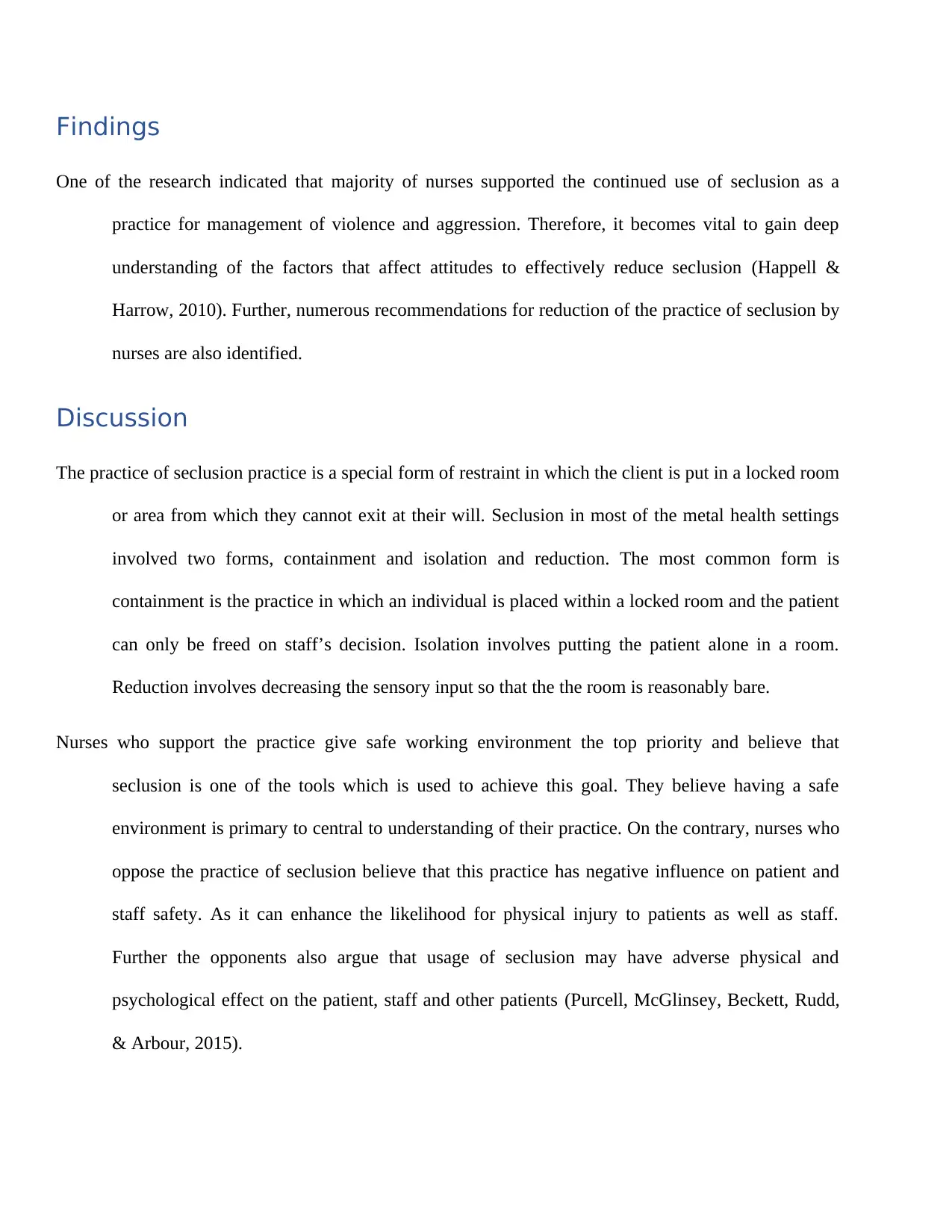
Findings
One of the research indicated that majority of nurses supported the continued use of seclusion as a
practice for management of violence and aggression. Therefore, it becomes vital to gain deep
understanding of the factors that affect attitudes to effectively reduce seclusion (Happell &
Harrow, 2010). Further, numerous recommendations for reduction of the practice of seclusion by
nurses are also identified.
Discussion
The practice of seclusion practice is a special form of restraint in which the client is put in a locked room
or area from which they cannot exit at their will. Seclusion in most of the metal health settings
involved two forms, containment and isolation and reduction. The most common form is
containment is the practice in which an individual is placed within a locked room and the patient
can only be freed on staff’s decision. Isolation involves putting the patient alone in a room.
Reduction involves decreasing the sensory input so that the the room is reasonably bare.
Nurses who support the practice give safe working environment the top priority and believe that
seclusion is one of the tools which is used to achieve this goal. They believe having a safe
environment is primary to central to understanding of their practice. On the contrary, nurses who
oppose the practice of seclusion believe that this practice has negative influence on patient and
staff safety. As it can enhance the likelihood for physical injury to patients as well as staff.
Further the opponents also argue that usage of seclusion may have adverse physical and
psychological effect on the patient, staff and other patients (Purcell, McGlinsey, Beckett, Rudd,
& Arbour, 2015).
One of the research indicated that majority of nurses supported the continued use of seclusion as a
practice for management of violence and aggression. Therefore, it becomes vital to gain deep
understanding of the factors that affect attitudes to effectively reduce seclusion (Happell &
Harrow, 2010). Further, numerous recommendations for reduction of the practice of seclusion by
nurses are also identified.
Discussion
The practice of seclusion practice is a special form of restraint in which the client is put in a locked room
or area from which they cannot exit at their will. Seclusion in most of the metal health settings
involved two forms, containment and isolation and reduction. The most common form is
containment is the practice in which an individual is placed within a locked room and the patient
can only be freed on staff’s decision. Isolation involves putting the patient alone in a room.
Reduction involves decreasing the sensory input so that the the room is reasonably bare.
Nurses who support the practice give safe working environment the top priority and believe that
seclusion is one of the tools which is used to achieve this goal. They believe having a safe
environment is primary to central to understanding of their practice. On the contrary, nurses who
oppose the practice of seclusion believe that this practice has negative influence on patient and
staff safety. As it can enhance the likelihood for physical injury to patients as well as staff.
Further the opponents also argue that usage of seclusion may have adverse physical and
psychological effect on the patient, staff and other patients (Purcell, McGlinsey, Beckett, Rudd,
& Arbour, 2015).
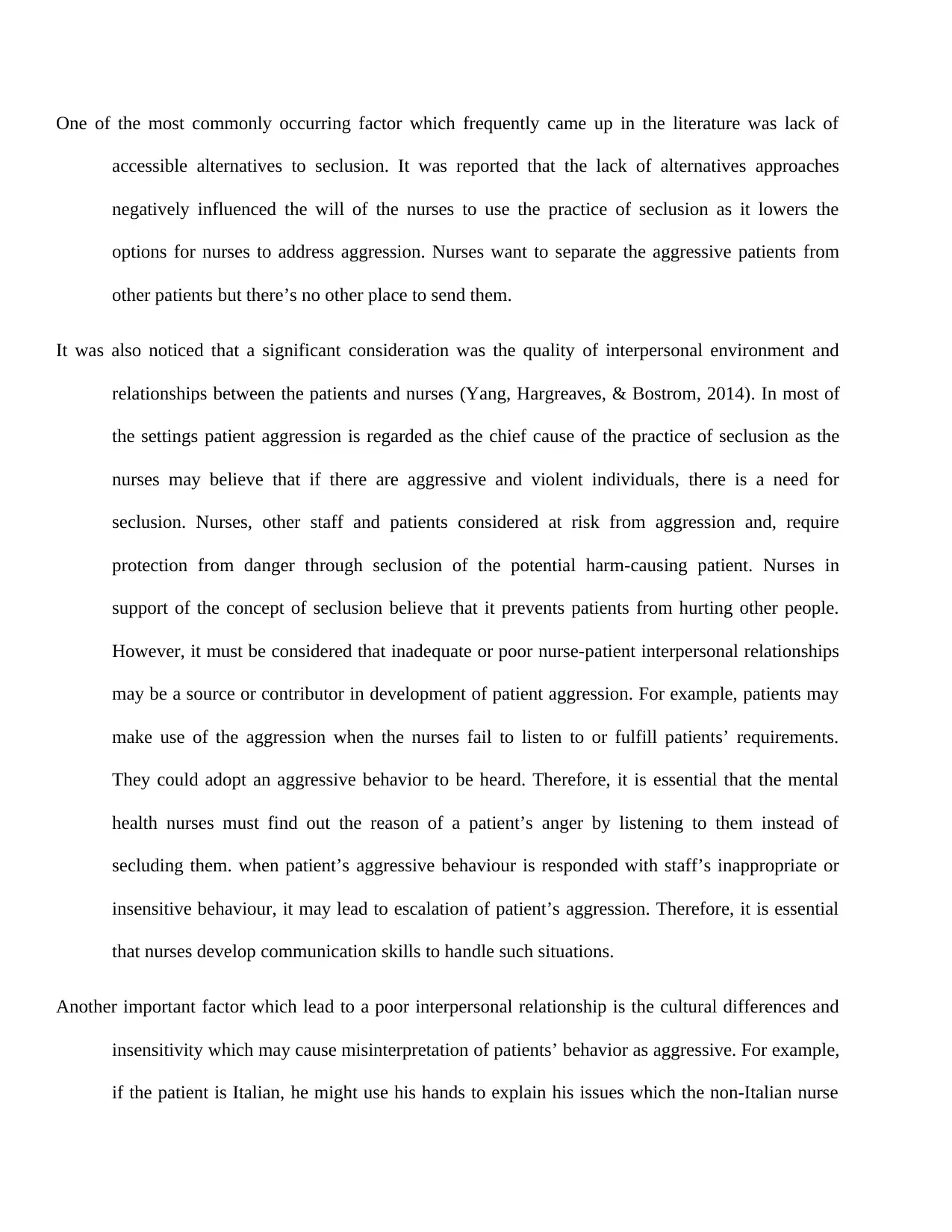
One of the most commonly occurring factor which frequently came up in the literature was lack of
accessible alternatives to seclusion. It was reported that the lack of alternatives approaches
negatively influenced the will of the nurses to use the practice of seclusion as it lowers the
options for nurses to address aggression. Nurses want to separate the aggressive patients from
other patients but there’s no other place to send them.
It was also noticed that a significant consideration was the quality of interpersonal environment and
relationships between the patients and nurses (Yang, Hargreaves, & Bostrom, 2014). In most of
the settings patient aggression is regarded as the chief cause of the practice of seclusion as the
nurses may believe that if there are aggressive and violent individuals, there is a need for
seclusion. Nurses, other staff and patients considered at risk from aggression and, require
protection from danger through seclusion of the potential harm-causing patient. Nurses in
support of the concept of seclusion believe that it prevents patients from hurting other people.
However, it must be considered that inadequate or poor nurse-patient interpersonal relationships
may be a source or contributor in development of patient aggression. For example, patients may
make use of the aggression when the nurses fail to listen to or fulfill patients’ requirements.
They could adopt an aggressive behavior to be heard. Therefore, it is essential that the mental
health nurses must find out the reason of a patient’s anger by listening to them instead of
secluding them. when patient’s aggressive behaviour is responded with staff’s inappropriate or
insensitive behaviour, it may lead to escalation of patient’s aggression. Therefore, it is essential
that nurses develop communication skills to handle such situations.
Another important factor which lead to a poor interpersonal relationship is the cultural differences and
insensitivity which may cause misinterpretation of patients’ behavior as aggressive. For example,
if the patient is Italian, he might use his hands to explain his issues which the non-Italian nurse
accessible alternatives to seclusion. It was reported that the lack of alternatives approaches
negatively influenced the will of the nurses to use the practice of seclusion as it lowers the
options for nurses to address aggression. Nurses want to separate the aggressive patients from
other patients but there’s no other place to send them.
It was also noticed that a significant consideration was the quality of interpersonal environment and
relationships between the patients and nurses (Yang, Hargreaves, & Bostrom, 2014). In most of
the settings patient aggression is regarded as the chief cause of the practice of seclusion as the
nurses may believe that if there are aggressive and violent individuals, there is a need for
seclusion. Nurses, other staff and patients considered at risk from aggression and, require
protection from danger through seclusion of the potential harm-causing patient. Nurses in
support of the concept of seclusion believe that it prevents patients from hurting other people.
However, it must be considered that inadequate or poor nurse-patient interpersonal relationships
may be a source or contributor in development of patient aggression. For example, patients may
make use of the aggression when the nurses fail to listen to or fulfill patients’ requirements.
They could adopt an aggressive behavior to be heard. Therefore, it is essential that the mental
health nurses must find out the reason of a patient’s anger by listening to them instead of
secluding them. when patient’s aggressive behaviour is responded with staff’s inappropriate or
insensitive behaviour, it may lead to escalation of patient’s aggression. Therefore, it is essential
that nurses develop communication skills to handle such situations.
Another important factor which lead to a poor interpersonal relationship is the cultural differences and
insensitivity which may cause misinterpretation of patients’ behavior as aggressive. For example,
if the patient is Italian, he might use his hands to explain his issues which the non-Italian nurse
⊘ This is a preview!⊘
Do you want full access?
Subscribe today to unlock all pages.

Trusted by 1+ million students worldwide

might perceive as violence. So, it is essential that the nurses familiarize themselves from the
culture of the service-user. Apart from the poor nurse-patient interpersonal relationship, other
factor which was identified was unfavorable physical environment. The adverse physical
conditions may lead to development of aggression between patient and therefore their subsequent
seclusion (Cochrane, McCann, Baird, & McCann, 2010).
For the lack of accessible alternatives to restraint and seclusion, it was found that having space where
patients could go, either of their own will, or being put there for a short time by the nurse, like in
a low stimulation area (LSA) or high dependency unit can be an effective alternative to
seclusion.
Further, it is also identified through the literature that the practice environment affect the decision of the
staff to implement of the practice of seclusion. Some of the factors which contribute are the
organizational policies about use of seclusion, low staff-to-patient percentage, degree of care
requirement by the patient, gender mix, focus on offering a safe environment to patients and staff
and adhering that seclusion is implanted rarely and as a last resort, as per the government
policies. Nurses must ensure that they are using the measure of seclusion appropriately and their
practice does not require any changes. Nurse at their level must also view seclusion as the last
resort and should only make this decision after careful evaluation. However, it is not completely
dependent on the nurses as the competency to handle mental health patients by using seclusion as
last resort depends on nurse-to-patient ratio, nurse education and nurse clinical experience. Nurse
may make use of the measure of seclusion due to pressure they are experiencing due to shortage
of staff and increased number of patients with challenging and aggressive behaviour. Therefore,
the reduction in usage of seclusion practice can be achieved through integrated efforts of
culture of the service-user. Apart from the poor nurse-patient interpersonal relationship, other
factor which was identified was unfavorable physical environment. The adverse physical
conditions may lead to development of aggression between patient and therefore their subsequent
seclusion (Cochrane, McCann, Baird, & McCann, 2010).
For the lack of accessible alternatives to restraint and seclusion, it was found that having space where
patients could go, either of their own will, or being put there for a short time by the nurse, like in
a low stimulation area (LSA) or high dependency unit can be an effective alternative to
seclusion.
Further, it is also identified through the literature that the practice environment affect the decision of the
staff to implement of the practice of seclusion. Some of the factors which contribute are the
organizational policies about use of seclusion, low staff-to-patient percentage, degree of care
requirement by the patient, gender mix, focus on offering a safe environment to patients and staff
and adhering that seclusion is implanted rarely and as a last resort, as per the government
policies. Nurses must ensure that they are using the measure of seclusion appropriately and their
practice does not require any changes. Nurse at their level must also view seclusion as the last
resort and should only make this decision after careful evaluation. However, it is not completely
dependent on the nurses as the competency to handle mental health patients by using seclusion as
last resort depends on nurse-to-patient ratio, nurse education and nurse clinical experience. Nurse
may make use of the measure of seclusion due to pressure they are experiencing due to shortage
of staff and increased number of patients with challenging and aggressive behaviour. Therefore,
the reduction in usage of seclusion practice can be achieved through integrated efforts of
Paraphrase This Document
Need a fresh take? Get an instant paraphrase of this document with our AI Paraphraser

organization and the nurses by having adequate, educated and experienced staff (Gerace & Muir‐
Cochrane, 2018).
Further, the level of care needed by the patient also affects the usage of seclusion on them. Apart from
that, seclusion practice also depend on the age and diagnosis of the patient. For example, staff
refrain from using seclusion on weak elderly or those suffering from dementia.
The literature demonstrated consensus over the recommendations that can be implemented to reduce the
practice of seclusion. The recommendations are required at various level but this research only
holds the scope for the role of nurses in reducing seclusion. A strong nursing leadership which
will evaluate these cases and take the most suitable decision is vital. The nurse leader should
make consultation available to nurses, including ethical consultation about decisions regarding
seclusion. Nurse leaders can lead the nursing workforce in right direction in using the measure of
seclusion. Further nurses must focus on bringing the change in organizational culture in
promoting minimization or eradication of seclusion. Further, the nurses should focus on
engagement and participation with the patients so that an interpersonal relationship based on
trust and empathy can be developed (O’Hagan, Divis, & Long, 2008).
Nurses should be educated along with other members of the interdisciplinary team so that they are
capable to take appropriate decision regarding the practice of seclusion. The education must
include suitable use of seclusion, and on the alternate options of the intervention. Nurses should
ensure that care of the patient is monitored and individualized with the aim of using seclusion
only when no other feasible option is available. Nurses should support the working environment
to offer viable substitutive options to seclusion and shift increasingly toward a seclusion-free
environment while giving a therapeutic safety for the patients. Nurses should focus on
documentation so they must be aware regarding what should be documented. Nurses should
Cochrane, 2018).
Further, the level of care needed by the patient also affects the usage of seclusion on them. Apart from
that, seclusion practice also depend on the age and diagnosis of the patient. For example, staff
refrain from using seclusion on weak elderly or those suffering from dementia.
The literature demonstrated consensus over the recommendations that can be implemented to reduce the
practice of seclusion. The recommendations are required at various level but this research only
holds the scope for the role of nurses in reducing seclusion. A strong nursing leadership which
will evaluate these cases and take the most suitable decision is vital. The nurse leader should
make consultation available to nurses, including ethical consultation about decisions regarding
seclusion. Nurse leaders can lead the nursing workforce in right direction in using the measure of
seclusion. Further nurses must focus on bringing the change in organizational culture in
promoting minimization or eradication of seclusion. Further, the nurses should focus on
engagement and participation with the patients so that an interpersonal relationship based on
trust and empathy can be developed (O’Hagan, Divis, & Long, 2008).
Nurses should be educated along with other members of the interdisciplinary team so that they are
capable to take appropriate decision regarding the practice of seclusion. The education must
include suitable use of seclusion, and on the alternate options of the intervention. Nurses should
ensure that care of the patient is monitored and individualized with the aim of using seclusion
only when no other feasible option is available. Nurses should support the working environment
to offer viable substitutive options to seclusion and shift increasingly toward a seclusion-free
environment while giving a therapeutic safety for the patients. Nurses should focus on
documentation so they must be aware regarding what should be documented. Nurses should

familiarize themselves and understand the ethical outcomes of secluding patients. They should
learn about government policies and organizational guidelines regarding the practice of seclusion
that clarifies when, where, and how clients are to be secluded and monitored while secluded.
Overall, it is essential that nurses must understand all the implications of allowing the
implementation of seclusion in health care facilities (Center for Ethics and Human Rights, 2012).
Conclusion
The usage of seclusion is prevalent in mental health care settings as a therapeutic intervention however,
its usage is debatable as it can result in exacerbation of the patient’s condition and harm the
patient as well as the staff by causing physical and emotional trauma to the patient. The research
provided clarification regarding the practice of seclusion. Several factors which contribute
towards provision of deep exploration of contextual influences sustaining resistance to
decreasing or eradicating the practice of seclusion. Some of the factors identified are lack of
alternative option of seclusion, the poor quality of interpersonal environment and relationships
between the patients and nurses, the cultural differences and insensitivity, use of seclusion, low
staff-to-patient percentage and degree of care requirement by the patient. Such contextual and
situational factors must be addressed to reduce the practice of seclusion meaningfully and
sustainably. Certain recommendations for minimizing the measure of seclusion are based on
education, consultation, support and collaboration. The ethical and workplace cultural issues
regarding the measure of seclusion must be considered. Comprehensive initiatives involving
interdisciplinary team must be developed and implemented to address violence and aggression
among patients. Further research is required to assess the efficiency of alternative options to the
practice of seclusion.
learn about government policies and organizational guidelines regarding the practice of seclusion
that clarifies when, where, and how clients are to be secluded and monitored while secluded.
Overall, it is essential that nurses must understand all the implications of allowing the
implementation of seclusion in health care facilities (Center for Ethics and Human Rights, 2012).
Conclusion
The usage of seclusion is prevalent in mental health care settings as a therapeutic intervention however,
its usage is debatable as it can result in exacerbation of the patient’s condition and harm the
patient as well as the staff by causing physical and emotional trauma to the patient. The research
provided clarification regarding the practice of seclusion. Several factors which contribute
towards provision of deep exploration of contextual influences sustaining resistance to
decreasing or eradicating the practice of seclusion. Some of the factors identified are lack of
alternative option of seclusion, the poor quality of interpersonal environment and relationships
between the patients and nurses, the cultural differences and insensitivity, use of seclusion, low
staff-to-patient percentage and degree of care requirement by the patient. Such contextual and
situational factors must be addressed to reduce the practice of seclusion meaningfully and
sustainably. Certain recommendations for minimizing the measure of seclusion are based on
education, consultation, support and collaboration. The ethical and workplace cultural issues
regarding the measure of seclusion must be considered. Comprehensive initiatives involving
interdisciplinary team must be developed and implemented to address violence and aggression
among patients. Further research is required to assess the efficiency of alternative options to the
practice of seclusion.
⊘ This is a preview!⊘
Do you want full access?
Subscribe today to unlock all pages.

Trusted by 1+ million students worldwide
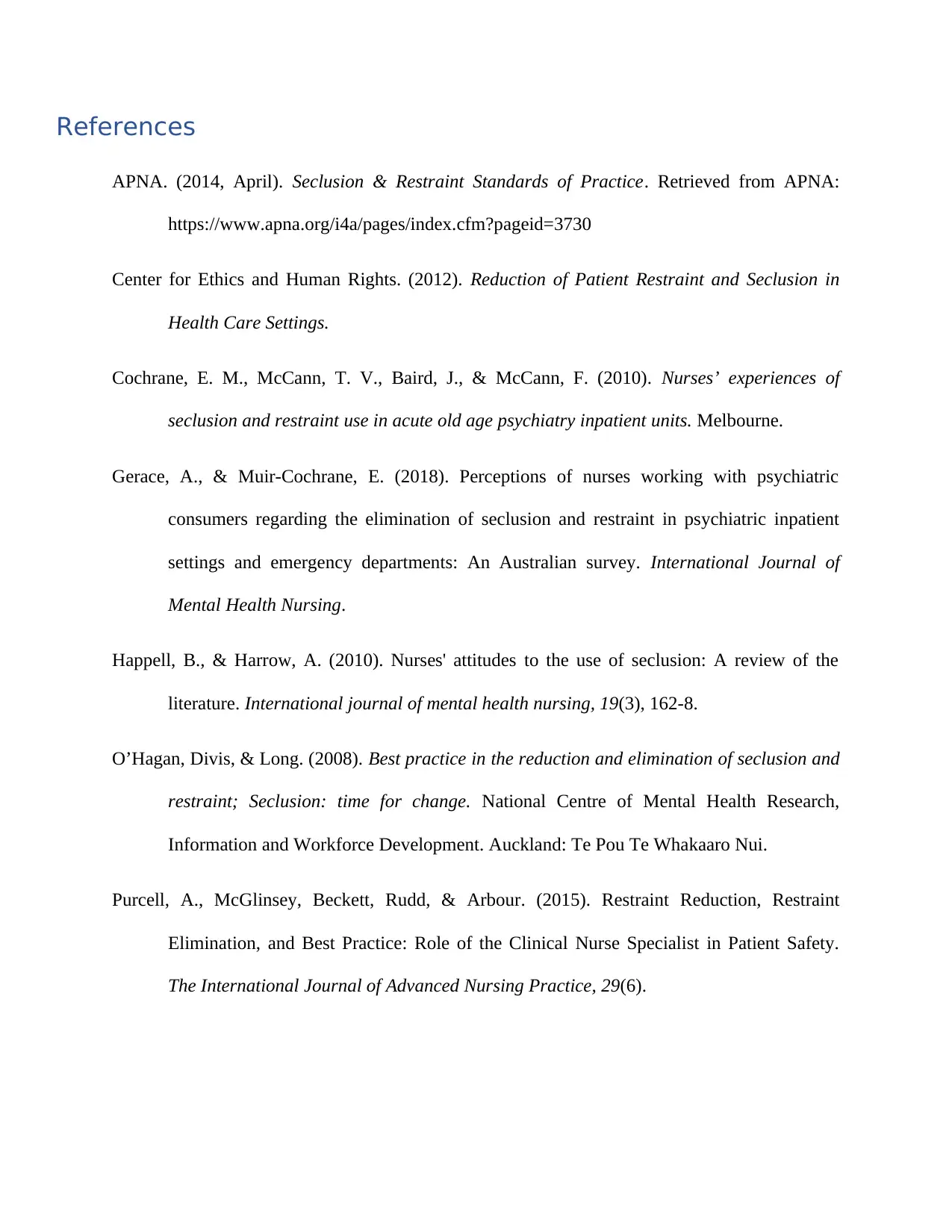
References
APNA. (2014, April). Seclusion & Restraint Standards of Practice. Retrieved from APNA:
https://www.apna.org/i4a/pages/index.cfm?pageid=3730
Center for Ethics and Human Rights. (2012). Reduction of Patient Restraint and Seclusion in
Health Care Settings.
Cochrane, E. M., McCann, T. V., Baird, J., & McCann, F. (2010). Nurses’ experiences of
seclusion and restraint use in acute old age psychiatry inpatient units. Melbourne.
Gerace, A., & Muir‐Cochrane, E. (2018). Perceptions of nurses working with psychiatric
consumers regarding the elimination of seclusion and restraint in psychiatric inpatient
settings and emergency departments: An Australian survey. International Journal of
Mental Health Nursing.
Happell, B., & Harrow, A. (2010). Nurses' attitudes to the use of seclusion: A review of the
literature. International journal of mental health nursing, 19(3), 162-8.
O’Hagan, Divis, & Long. (2008). Best practice in the reduction and elimination of seclusion and
restraint; Seclusion: time for change. National Centre of Mental Health Research,
Information and Workforce Development. Auckland: Te Pou Te Whakaaro Nui.
Purcell, A., McGlinsey, Beckett, Rudd, & Arbour. (2015). Restraint Reduction, Restraint
Elimination, and Best Practice: Role of the Clinical Nurse Specialist in Patient Safety.
The International Journal of Advanced Nursing Practice, 29(6).
APNA. (2014, April). Seclusion & Restraint Standards of Practice. Retrieved from APNA:
https://www.apna.org/i4a/pages/index.cfm?pageid=3730
Center for Ethics and Human Rights. (2012). Reduction of Patient Restraint and Seclusion in
Health Care Settings.
Cochrane, E. M., McCann, T. V., Baird, J., & McCann, F. (2010). Nurses’ experiences of
seclusion and restraint use in acute old age psychiatry inpatient units. Melbourne.
Gerace, A., & Muir‐Cochrane, E. (2018). Perceptions of nurses working with psychiatric
consumers regarding the elimination of seclusion and restraint in psychiatric inpatient
settings and emergency departments: An Australian survey. International Journal of
Mental Health Nursing.
Happell, B., & Harrow, A. (2010). Nurses' attitudes to the use of seclusion: A review of the
literature. International journal of mental health nursing, 19(3), 162-8.
O’Hagan, Divis, & Long. (2008). Best practice in the reduction and elimination of seclusion and
restraint; Seclusion: time for change. National Centre of Mental Health Research,
Information and Workforce Development. Auckland: Te Pou Te Whakaaro Nui.
Purcell, A., McGlinsey, Beckett, Rudd, & Arbour. (2015). Restraint Reduction, Restraint
Elimination, and Best Practice: Role of the Clinical Nurse Specialist in Patient Safety.
The International Journal of Advanced Nursing Practice, 29(6).
Paraphrase This Document
Need a fresh take? Get an instant paraphrase of this document with our AI Paraphraser
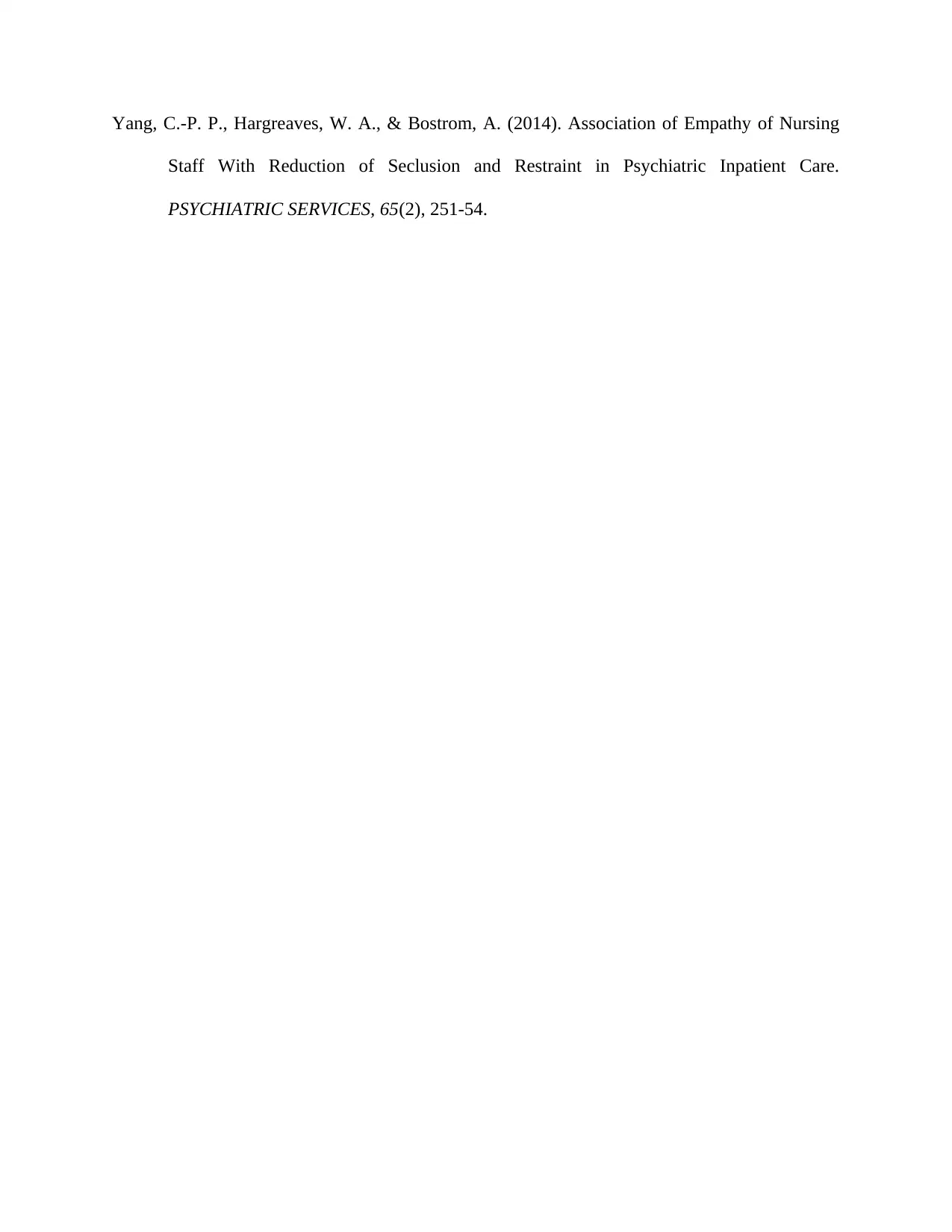
Yang, C.-P. P., Hargreaves, W. A., & Bostrom, A. (2014). Association of Empathy of Nursing
Staff With Reduction of Seclusion and Restraint in Psychiatric Inpatient Care.
PSYCHIATRIC SERVICES, 65(2), 251-54.
Staff With Reduction of Seclusion and Restraint in Psychiatric Inpatient Care.
PSYCHIATRIC SERVICES, 65(2), 251-54.
1 out of 11
Related Documents
Your All-in-One AI-Powered Toolkit for Academic Success.
+13062052269
info@desklib.com
Available 24*7 on WhatsApp / Email
![[object Object]](/_next/static/media/star-bottom.7253800d.svg)
Unlock your academic potential
Copyright © 2020–2025 A2Z Services. All Rights Reserved. Developed and managed by ZUCOL.





